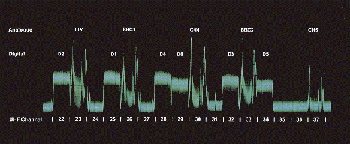| With the current
debate raging in the US about 8VSB vs. COFDM here is a piece on DTV in
the UK.
DTV
began in the UK on November 15 1998, twenty-nine years to the day after
PAL color television. It uses DVB-T COFDM transmission (mode 64QAM, FEC
2/3, guard interval 1/32, 2000 carrier version.) There are currently over
thirty stations in the DTV grid providing 37 SDTV/EDTV channels in 6 x
8 MHz UHF channels broadcast from each station. UK population coverage
has now passed 75% and is expected to reach 90% by Christmas 1999. Each
channel has a payload data rate of 24. 1 Mbit/sec carrying an ensemble
of DTV services. Stations transmit between 20 - 27 dB below their PAL counterparts
to achieve equivalent coverage typically 50-60 miles radius, although in
some instances DX -COFDMers are receiving DTV 90 miles away! Minimum clear
sky C/N to successfully decode is 18.5 dB in very easy locations and in
the worst possible urban/hilly multipath areas is around 25dB. Although
these numbers may seem interesting it is to be remembered that a Grade
5 PAL picture requires a C/N of 44dB. Therefore the existing installed
antenna base is perfectly adequate to receive DTV. In most locations simple
10 element antennae suffice and in Grade B contours eighteen elements,
which are preinstalled for analogue use, usually suffice.
The COFDM DTV
system is designed to work with today's antenna technologies:
2. In
City and Grade A contours portable indoor antenna reception of DTV is widespread
using either simple rabbits ears or amplified indoor antennae ($30). Unlike
8VSB, COFDM works very effectively with amplified signals as the interferers
are added constructively and the system can handle 0dB echoes common in
urban areas. Indoor DTV reception has become increasingly popular in condos
for those who would otherwise have to wait for channelised MATV systems
to be upgraded to DTV by building owners.
3. The
system is immune to multipath, which is why you will frequently see off-air
demonstrations of DTV in downtown retail shopping malls, rather than server
sourced demos. The BBC conducted a detailed DTV reception survey concluding
that, to date, no areas have been detected where DTV reception is prevented
by multipath impairment. (The chosen COFDM mode handles echoes as long
as 28uS, but itís believed that the worst echoes in the UK are under 20uS). With
the free STB business model current DTV penetration stands at 300,000 DTV
users (equivalent to 1.2 million homes in the US market) and is expected
to reach 500,000 before Christmas. The 'plug and play' nature of COFDM
DTV, its immunity to multipath, reuse of legacy antennae systems, the channel
line-up, the introduction of widescreen TV, and its robust reception on
indoor antennae have been contributory factors to growing consumer acceptance
nine months after launch.
|
